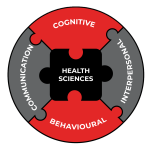5.7 Program: Medical Radiation Technology
The Medical Radiation Technologist (MRT) uses x-ray radiation to create images of the tissues, organs, bones and vessels that make up the human body. MRTs use their expert knowledge of imaging and equipment, together with an extensive understanding of the principles of anatomy, physiology and pathology, image acquisition, treatment and radiation protection to deliver quality care to their patients. MRTs always ensure the care provided is safe, appropriate, tailored, timely, and maximizes the potential of the available equipment and resources (CAMRT, n.d.).
Video: Medical Radiation Technology
Video: “Medical Radiation Technology” by Fanshawe College [0:58] Transcript Available.
About the Profession
A Medical Radiation Technologist (MRTR) produces images of the body part or system using equipment that emits x-rays that will be interpreted by a Radiologist to help make a diagnosis and treatment plan. Using a variety of modalities such as general x-ray, CT and fluoroscopy the radiological technologist (MRTR) works closely with patient to ensure they are in the correct position to patient safety and quality images. More information on the role of and MRT(R) can be found at CAMRT – Description of Practice
Places you might find yourself employed include
Hospitals, community clinics, doctors’ offices, government agencies, public health agencies, industrial medical service units, military bases, or private or public Medical Imaging Departments.
Program Fit
What personal qualities should someone interested in the career have?
- A sense of responsibility and a high degree of integrity
- The ability to maintain a high level of accuracy in their duties
- Patience and adaptability
- An interest in science and technology
- Good problem solving and critical thinking skills
- Empathic
- Handle situations involving blood/graphic and traumatic cases
- Sensitivity to the needs of ill and injured people
- Good communication skills and the ability to put people at ease
- The ability to work well in a team environment
- Maintain poise and composure in stressful situations
- Be a people person
- Work with people in vulnerable situations
- Willingness to keep skills and knowledge up to date
- Good organizational skills
What kind of work could I do when I graduate?
Graduates of this program may go on to become a Radiologic Technologist MRT (R); or work in technical support/administration; or be an application specialist/sales.
Places you may find yourself employed include:
Hospitals, community clinics, doctors’ offices, government agencies, public health agencies, industrial medical service units, military bases, or private or public Medical Imaging Departments.
Typical working conditions for this kind of work:
- Those employed in community clinics work regular office hours but may be required to work some evenings and weekends
- This is a physically demanding occupation. Medical Radiation Technologists are on their feet for most of their shift. They handle very heavy equipment, move equipment positioned at heights of about 2 metres, lift accessory equipment weighing up to 10 kilograms, and help patients move.
- Medical Radiation Technologists must follow strict radiation safety precautions for themselves and their patients, and be prepared to respond to and manage emergency situations
- Working with new technologies, there is a need for continual study to keep informed
- Working with doctors, nurses, radiologists and other medical staff
Tasks a graduate may do in the workplace
The profession of radiological technologist involves a broad variety of procedures and covers a number of specialties, including: Plain film radiological technology, i.e., x-rays of the chest, bones, joints, gastrointestinal studies, spine; Mammography to detect breast cancer in its earliest stages; Angiography to examine the heart, blood vessels and blood flow; Fluoroscopy, i.e., real-time images that show movement; Computerized tomography (CT scans), i.e., detailed cross-sectional images of the body.
- Explain procedures to patients and answer questions
- Help patients prepare for procedures, when necessary
- Monitor patients during procedures
- Provide primary patient care while patients are in the diagnostic imaging department
- Ensure patient comfort and privacy
- Interpret physicians’ requests for radiological examinations
- Use appropriate techniques and positioning for different pathological conditions
- Correctly position patients and equipment
- Inject contrast media when required
- Operate diagnostic imaging equipment to produce quality images that assist in diagnosis
- Recognize various anatomical structures radiographed
- Critique images to ensure high quality results
- Follow radiation protection practices, regulations and philosophy to reduce risk to patients, staff and visitors
Becoming a Medical Radiation Technologist
The Medical Radiation Technology program at Fanshawe College is a 7 term, 104 week Ontario College Advanced Diploma program starting in September each year. The program workload is considered to be heavy with:
- Seven courses in your first semester
- 2 – 3 hours of study required for each hour in class
- 25 -28 hours of class (70 hour/week commitment minimum)
Students spend the third year of the program in a hospital placement.
The program does go through the summer during the placement terms. Students are encouraged to research the placement locations as they may be required to travel or relocate.
Program terms are as follows:
- Level 1 – September to December
- Level 2 – January to April
(summer break) - Level 3 September to December
- Level 4 –7 Clinical
- Level 4 -January to April
- Level 5 May to August
- Level 6 September to December
- Level 7 January to April
The courses you would take at Fanshawe College can be found on the Medical Radiation Technology page.
Helpful links for further research into this Fanshawe College program and career opportunity

CAMRT certification exam
Registration with College of Medical Radiation Technologists of Ontario (CMRTO) required to work in Ontario
Canadian Association of Medical Radiation Technologists (CAMRT)
Fanshawe’s library has prepared a subject guide for current students in this program. You may find the links and information provided very useful in learning more about this career.
Opportunities for further development or education
Graduates may apply for the Medical Resonance Imaging graduate certificate
Course work may be used as a basis of university admission or credits may transfer to a university degree at many different schools. Pathways & Credit Transfer
Fanshawe Pathfinder: Medical Radiation Technology © Fanshawe College used with permission, All Rights Reserved
Admission Requirements:
Medical Radiation Technology Requirements
Related careers and Pathways
The MRT profession today includes a diverse array of highly-trained professionals representing various technology-related disciplines in the healthcare field:
Magnetic Resonance Technologists
Nuclear Medicine Technologists
More information: The MRT Profession
PHS Graduates:
Are given additional consideration when applying to 3 year advanced diploma certificate program.
Lindsay Grozell
MRT(R)
| Current Employer |
LHSC at University Hospital in the MRI Department |
| Skills you use professionally |
teamwork, dedication, time management, positive attitude, passion, empathy, and communication |
| Favourite thing about your job |
Supporting patients through hard times while providing them with imaging required to help them with their diagnoses. |
| Credentials/Past Professional Experiences |
Medical Radiation Advanced Diploma Program, Fanshawe College CTIC (CT Imaging Certificate)MRI (Magnetic Resonance Imaging) NAIT InstituteMRI Safety Officer CourseLeadership Skills Courses, CAMRTPre-Health Science Certificate, Fanshawe College |
| One thing you would tell your student self |
Continue with any Professional Development of Degree completion options. |


